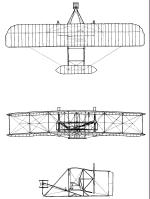|





Meanwhile:
How about a
little music?
We have a selection of tunes that were
popular during the first days of aviation, performed by Sue Keller, courtesy the
Ragtime Press:
Want to ask a question? Tell
us something? Arrange a showing of one of our airplanes? Ping:
mailto:[email protected]
| |
 olks often ask us where they
can get plans for replicas and models of the 1903 Wright Flyer and other Wright
airplanes. The answer depends on what you want to
build. olks often ask us where they
can get plans for replicas and models of the 1903 Wright Flyer and other Wright
airplanes. The answer depends on what you want to
build.
|
|
Three-Views
If you want to
make a small model without a great deal of detail, then a simple
"three-view" is sufficient. "Three-view" is
engineering slang for a drawing that combines the top, front, and side
elevations of an object -- in this case, an airplane. We have
gathered up the three-views for 9 different Wright airplanes, including
the Flyer 1, then scanned them at a sufficient resolution to make large,
crisp, detailed prints. You can download these from our Three-Views
page.
|

A three-view of the 1903 Wright Flyer 1. You can
download a large version of this for free. |
Scale Model Plans
If what you have in mind is a
very detailed model of the Flyer, we recommend a book "Paul Matt Scale
Airplane Drawings, Volume 2," published by Aviation Heritage, Inc. Near
the back of the book, there is an excellent set of drawings -- top view, side
view, front view and some important details. If you have slightly larger
ambitions, or your eyesight isn't what it used to be, you can order a large
version of these drawings on two 18" x 24" sheets. You can use
their online catalog at: http://www.aviation-heritage.com/
cgi-bin/catalog.cgi.
Be patient; the catalog seems to take forever to load. But when it finally
does, scroll down toward the bottom of the page and click on
"Paul Matt Scale Drawings V-W." This will take you to a
list of plans; the Wright Flyer is second from the bottom. The order number is 0-123A.
|


Paul Matt's drawings -- not large enough to use, but
large enough that you can get an idea of their superb detail.
|
Plans for full-size replicas
If you're
planning to reproduce the 1903 Wright Flyer 1, or want detailed
information on the construction of the aircraft and engine for your own
enjoyment and edification, you can obtain a complete set -- 50 sheets of
drawings -- from the National Air and Space Museum.
To do this, first download their "Wright 1903 Flyer Drawings"
order form from the following web page: http://www.nasm.edu/nasm/arch/wrights.html.
Please note that you can not order these drawings online. You must
download the order form (or request it via e-mail), print it out, sign the
"Document Use and Indemnification Agreement" attached to form,
and send it in with a check or money order. The NASM needs you to sign the
form to indemnify themselves should you crash and burn in your replica.
If that's your plan, by the way -- build a flying replica -- you
would be wise to read closely the second paragraph on the order form.
"The Wrights made no drawings of this aircraft..." it warns, and
goes on to say that it was heavily damaged in 1903, went through a flood
in 1913, was rebuilt once in 1916 and again in 1925, at a time when
aircraft conservation standards were non-existent. As a result,
"there will always be some doubt about the configuration of the
aircraft during the 1903 flights."
You should also be aware that there have been several aerodynamic studies
on the Flyer in its restored configuration that have shown it's a real
bear to handle. It's worst problem seems to be pitch instability -- it
"porpoises" in flight, and you need the reactions of a trained
athlete to control it. Fredrick J. Hooven, one of the engineers who
studied the Flyer, wrote that the pilot needed to react in 6/100ths of a
second -- any slower and he would lose control. That, said Hooven,
"is in the same range as a professional baseball player needs to hit
a fast ball."
Most recently, members of the American Institute of Aeronautics and
Astronautics (AIAA) performed exhaustive wind tunnel tests on a full-scull
replica at NASA Ames in California. Their conclusion was much the same as
engineers that had gone before them -- the Flyer was an exceedingly
difficult and dangerous machine to fly in it's present
configuration. They now hope to use the data they gleaned from the
wind tunnel tests and other studies to adjust the configuration and make a
Flyer look-alike that's reasonably safe to fly. You can read about this
project at: http://www.wrightflyer.org/
|

The Smithsonian shows this standard
"negative" blueprint, but this hasn't been available since the
days when they reproduced these drawings with ammonia printers. The
drawings come blue on white.

The Smithsonian also distributes this high
resolution scan of the first page of the Flyer bueprints, free to
all comers. We downloaded it and posted the drawing here in case you'd
like a copy.
|
And then there's us
That's right. The Wright Brothers Aeroplane Company is a major source
of engineering drawings for Wright aircraft and other Wright artifacts. Fact is,
we offer a few plans that you just can't get anywhere else. Some
of these, such as the 1899 Wright Kite
and the 1902 Wright Glider, we have
posted here for the benefit of young people and to do our part to celebrate
the Centennial of Flight in 2003. For a complete listing, see our page of WBAC
Plans. |

This sheet comparing the 3-views and specifications
of the 1900, 1901, and 1902 Wright gliders is one example of the plans we
offer that you can't get anywhere else. |
Back to the top
|

